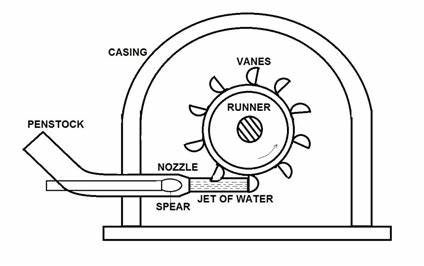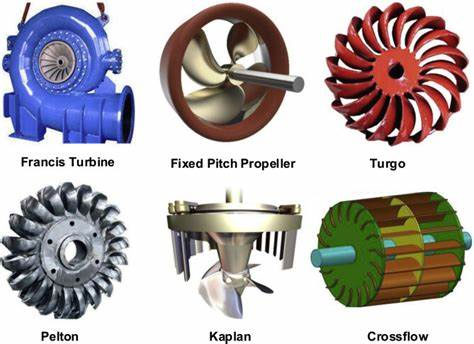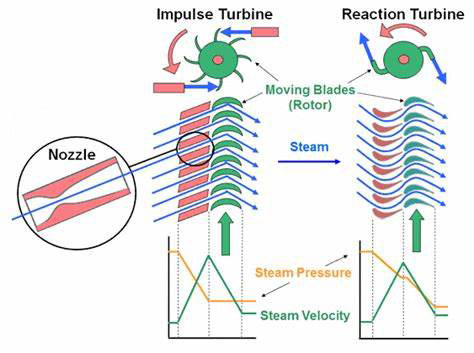Water Turbine Basics: Types, Component and Advantages
Water turbine is a power machine that converts the energy of water flow into rotating mechanical energy, thus driving the generator to send out electric energy, which is one of the power equipments of hydropower station. Water turbine belongs to the turbomachinery in the fluid machinery. As early as around 100 B.C., the prototype of hydraulic turbine - water wheel appeared in China, which was used to lift irrigation and drive grain processing equipment.
Most modern water turbines are installed in hydroelectric power stations to drive generators to produce electricity. In a hydroelectric power plant, water from the upstream reservoir is led to the turbine through a diversion pipe, which pushes the turbine runner to rotate and drive the generator to produce electricity. The water that has completed its work is discharged downstream through the tailrace pipeline. The higher the water head and flow rate, the greater the output power of the water turbine.
Working Principle of Water Turbine
Usually, centralized water head measures (such as dam construction and runoff regulation) are taken to convert the potential and kinetic energy contained in natural water flow into mechanical energy through a water turbine, and then convert it into electrical energy through an electric generator. Finally, it is sent to the electrical power system or directly supplied to users through transmission and transformation facilities.

Type of Water Turbine
According to the different ways in which the runner converts water flow energy, water turbines are divided into two categories:
Reaction Water Turbine
- Definition: A turbine that utilizes the potential and kinetic energy of the water flow to do work.
- Characteristics: The blades of the rotor are twisted in space, the flow of water through the rotor is continuous, and at the same time, all the runners between the blades of the rotor have water passing through them, and the flow of water fills up the rotor chamber.
- Principle: As the water flows through the rotor blades, the magnitude and direction of the flow velocity changes, and therefore the momentum changes. The flow generates a reaction force, which acts on each of the rotor blades to generate a rotating torque on the rotor, and thus work is done.
- Main components:
a. Water intake (water diversion) parts, a worm shell
b. Water-guiding mechanism (guide vane and control equipment)
c. Runner (work core)
d. water discharge components (tailpipe) - Types:
a. Mixed Flow Turbine
b. Axial-Flow Turbine
c. Diagonal Flow Turbine
d. Straight-Flow Turbine

Impulse Water Turbine
- Definition: Composed of a nozzle and a runner, it has a high water head and low flow rate, and is mostly used for distances above 400 meters, with a maximum of nearly 2000 meters.
- Characteristics: Impact turbine runner by the impact of the jet stream and rotating, the working process is mainly the conversion of kinetic energy and water pressure is unchanged, in the same moment, the water flow is only impacted by a part of the runner, but not all.
- Principle: It consists of nozzle and rotor. The water flow impacts the runner in the form of free water flow (P=Pa), and the kinetic energy of the water flow (V direction and size change) is utilized to generate the rotating torque to make the runner rotate.
- Main components:
a. Nozzle
b. Runner
c. Refractor
d. Casing
e. Jet brake - Types:
a. Pelton Turbine (Cutting Turbine)
b. Turgo Turbine
c. Banki Turbine
Difference between Impulse and Reaction Water Turbine
In terms of working principle: the reaction turbine utilizes the potential energy and kinetic energy of water flow to do work; The impulse turbine utilizes the kinetic energy of water flow to do work.
In terms of flow characteristics: the flow channel of the reaction turbine runner is pressurized, closed, and full cycle inflow; The runner channel of the impulse turbine is pressure free, open, and partially filled.
In terms of structural characteristics: If there is a difference in the runner, whether there is a nozzle or draft tube.

Advantages of ATO Water Turbine
ATO provides professionally designed and manufactured turbines. Our turbines have the following advantages:
- Long life and low maintenance costs: Water turbines usually have a long life, especially if they are properly maintained. Their maintenance costs are usually low because they are relatively stable in operation and do not require a large fuel supply.
- High efficiency: Modern water turbines are efficiently designed to convert water energy into mechanical or electrical energy. This makes turbines very efficient at energy conversion and allows for high energy yields.
- Renewable energy: Water turbines utilize the energy of water to generate electricity; water is a renewable resource, making water turbines an environmentally friendly energy option. Water flow is driven by natural rainfall and snowmelt, so turbines do not run out of energy.
- Low pollution: Using turbines to generate electricity produces no air pollution or greenhouse gas emissions. They have a lower impact on the environment and are cleaner than fossil fuel-based power generation.
- Stable base load: Water turbines can provide stable base load power because the water flow is usually steady, unlike solar and wind power which are subject to weather changes.
Water turbines are an environmentally friendly and renewable energy source, as they generate electricity without producing greenhouse gas emissions. They have been used for centuries to power mills, factories, and generate electricity for homes and industries. In modern times, water turbines are a vital component of hydropower plants, contributing to the generation of clean and sustainable electricity. With ATO automation shop, you get not only a superior product but also comprehensive technical support and customized solutions tailored to your specific site conditions.

